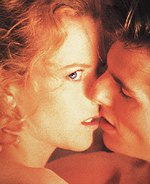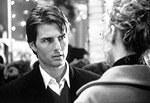As I do on the first day of every month, on September 1, I was practicing being worldly and jaded when a call from Warner Bros. ruined my concentration. “Tom Cruise and Nicole Kidman will be at the Ritz tomorrow for a press conference,” said the friendly voice. “Would that interest you?” My “jaded practice” was shot to hell, so I said, “You bet!”
The only previous time I’d been in the same room with Tom and Nicole was at Cannes in 1992 when Ron Howard’s Irish immigrant saga “Far and Away” closed the festival. Even at a distance, Cruise actually seemed to glow, but — partly a function of the questions they were asked and partly out of a professional desire to withhold anything unpracticed about themselves — the celeb couple came across as cordial but artificial, as though they’d checked their inner lives and were waiting for left luggage to open.
Seven years later, the Cruises are practically rambunctious, so forthcoming are they with the ladies and gents of the fourth estate. They’ve also made some sort of Dorian Gray-style pact with the gods of air travel. The gala European premiere of “Eyes Wide Shut” had been the night before in Venice, two days before that they were in Australia, today they were in Paris and tomorrow they’d be in London. Given sufficient funds, I’m sure much can be done to take the edge off this sort of schedule, but personally, I came down with jet-lag just typing their itinerary.
Cruise and Kidman loved working with Stanley Kubrick. The director’s death in March, mere days after turning in the finished film, was a major blow. But Kubrick lives on in the impressions and memories his last leading man and lady are eager to share. They couldn’t have been more open on “Shut.”
Q: How did you go about creating the scene in which Alice (Kidman) reveals to Bill (Cruise) that she was anything but indifferent to a young naval officer she’d glimpsed at their hotel during a vacation?
NK: We worked on it for two or three weeks. It’s a pivotal scene in the film. It’s rare as an actor that you’re asked to speak for more than two or three minutes, and that speech is a major monologue. We spent time in the room on the set and we worked on the scene. Stanley rewrote it and we worked on it again. It was incredible how he decided to shoot it — he constructed the shot watching us. We got to play the whole scene without having to cut — so it was more like theater. Some directors like you to do the scene the same way every time. Stanley liked extremes. He’d say to me, “I’m not interested in realism.”
TC: He felt that anyone could be “real,” but he was interested in what excited him. Stanley never specified that he wanted to cast a real-life couple. Somebody wrote that and it stuck. But that was never one of Stanley’s priorities.
NK: There’s an intimacy, though, as a married couple that can be a useful shortcut. You can touch each other. As actors working together “cold,” you often have to build up that trust. Tom and I were connected in work and in our private lives 24 hours a day.
Q: You worked on this film for what seemed like forever. Was that a strain?
NK: You enter into a different world. We’d go to Pinewood Studios every day for a year and a half. We lived in England, our kids were in school there. People would say, ‘Wasn’t that hard?’ and I’d say, ‘No, it wasn’t hard.’ I was working on a film I believed in with a director I believed in. Stanley was wickedly funny. Very, very dry sense of humor. Being Australian, I love that.
TC: He was very considerate. Patient. Kind. Always concerned about us and our comfort on the set. Did I have enough to eat? (laughs) He had vast knowledge. Incredibly charming.
Q: Did you ever argue with him?
NK: Oh, yeah! Stanley I think wouldn’t have respected you if you didn’t argue with him. He never held a grudge. No matter what would happen, every day was a new day.
Q: We often hear about how a director will “close” the set. What does that mean?
TC: The most important thing to Stanley was TIME. A lot of films get made based on when they’re supposed to come out in theaters: “This is due out in June so we’ll shoot it in February and it’ll just have to be ready.” That’s often a necessity because filmmaking is so expensive, but it’s not the ideal way to work. When Stanley was writing he was writing, when he was directing he was directing, when he was editing he was editing. Ideas take time. He worked non-stop. I’d get faxes from him that arrived at 3 or 4 in the morning and read them over breakfast. He rewrote every single day. There wasn’t a large crew. It was an intimate group. He can operate the camera — sometimes it was just Stanley. If there was dialogue, a soundman. Even then: radio mikes. It was a great way to work. Stanley’s just a stunning artist. When you look at his pictures, alone or collectively — they’re art. And art challenges you. I know I’ll never have another experience like that. To have shared that experience with my love, my best friend... (his voice cracks with emotion as he throws a knowing glance at Kidman).
NK: There are times in your life when it “feeds” you for much more than the here and now. Playing Isabel Archer [in Jane Campion’s “The Portrait of a Lady”] changed me, for example. I basically received my film education from Stanley Kubrick. He gave me the Decalogue series [Krzysztof Kieslowski’s 10 films, originally made for Polish television, based on the Ten Commandments] and said, “Watch this — it’s some of the greatest filmmaking ever made.” I went home and we watched it together in bed and went, “Oh my God.”
Q: Because all concerned did such an outstanding job of maintaining secrecy during production, some wild rumors emerged about the script and your characters. You must have had a good laugh about some of the reports. What were the silliest, most off-base things you heard?
NK: I was a junkie...
TC: I was wearing a dress...
NK: I wouldn’t mind seeing you in a dress!
TC: Well, I would!
NK: Rumor had it we were two psychiatrists [Bill is a GP and Alice is a housewife who used to work in an art gallery] and the psychiatric board was outraged about that. It’s interesting how, if you do not dispel a rumor, in 24 hours it can become fact. Nobody confirmed or denied anything for about a year and a half. You’d read the most outlandish things in reputable newspapers that were supposed to be factual.
As Kidman and Cruise were about to leave for their television interviews, a reporter in the back of the Salon César Ritz said, “How ’bout an orgy?” Tom and Nicole shrugged and said, “Sure, why not?” As waiters served petits fours and poured flutes of champagne, we set aside our notepads and tape recorders and doffed our duds in the interests of thorough reporting. When the space aliens entered through the garden patio, I decided I’d had enough group sex with celebrities for one day and headed back to the offices of this reputable newspaper to file the story.









